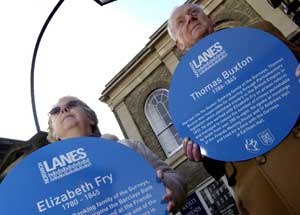Social reformers honoured in Norwich

Christian social reformers
Elizabeth Fry and
Sir Thomas Buxton are among the figures commemorated in a new series of blue plaques appearing around
Norwich.
Ten plaques have already been put up around the Lanes area of the city marking locations of historical and cultural interest and there are plans for many more across the city centre.
On February 6, 2007, two plaques were unveiled at The Friends' Meeting House on Upper Goat Lane to commemorate prison reformer Elizabeth Fry and her brother in law Sir Thomas Buxton a leading figure in the campaign to abolish slavery.
Elizabeth was born at Gurney Court, Magdalen Street, Norwich, into the Gurneys, the Quaker family who founded what was to become Barclays Bank. In 1786 the family moved to Earlham Hall (now part of the UEA). She remained there until she married Joseph Fry in 1800 and moved to London.
She worshipped at The Friends' Meeting House. The turning point in her life appears to have been when the American Quaker William Savery visited Goat Lane in 1798, following which she took her Quaker Christian faith far more seriously, adopted traditional Quaker dress and speech and devoted the rest of her life to preaching, campaigning for prison reform and other philanthropic concerns.
Sir Thomas was an MP, brewer and social reformer who married Elizabeth's sister Hannah Gurney in 1807.
Although he was a member of the Church of England, he attended Friends meetings with the Gurneys and become involved in the social reform movement led by the Quakers. He worked with Elizabeth on prison reform and managed to reduce the number of crimes punishable by death from more than 200 to eight.
The slave trade was abolished in 1807, and March marks the 200th anniversary, but Sir Thomas worked for the complete abolition of slavery. He took over as leader of the abolition movement in the House of Commons after William Wilberforce retired in 1825 and in 1833 his efforts paid off when slavery was officially abolished in the UK.
Sir Thomas also features on the current English £5 note, he is the figure wearing glasses in the group on the left of Elizabeth. The latest unveiling was attended by his great, great, great grandsons Sir Jocelyn Buxton and John Buxton.
John, 79, said: “I suppose I was two or three when I became aware of him and his achievements. It's always been a family thing to be proud of and it's rather good that there's something to commemorate him in Norwich.”
Sir Jocelyn, 82, said: “It always makes me very humble and ashamed that I'm not up to the same standard. I hope one day as many people will know about Thomas as Wilberforce.”
Also at the ceremony was Julie Benson of Norwich and Norfolk Racial Equality Council who said: “It's excellent and it's especially relevant because this is the bicentenary of the abolition of the transatlantic slave trade.”
The plaques have been put up by Norwich Heart (Heritage Economic and Regeneration Trust). There are already 120 plaques marking places of interest in Norwich.
Mike Loveday, chief executive of Norwich Heart, said: “We find if you give people the information they become very proud and excited by it. Some of the most iconic people in the UK have some connection with Norwich. We believe the city has got some fantastic stories that aren't the subject of current plaques.”
Pictured above are plaques commemorating anti-slavery campaigner Sir Thomas Buxton and prison reformer Elizabeth Fry, were unveiled by Sir Jocelyn Buxton and Sue Debbage, warden of the Friends’ Meeting House, in Upper Goat Lane, Norwich.